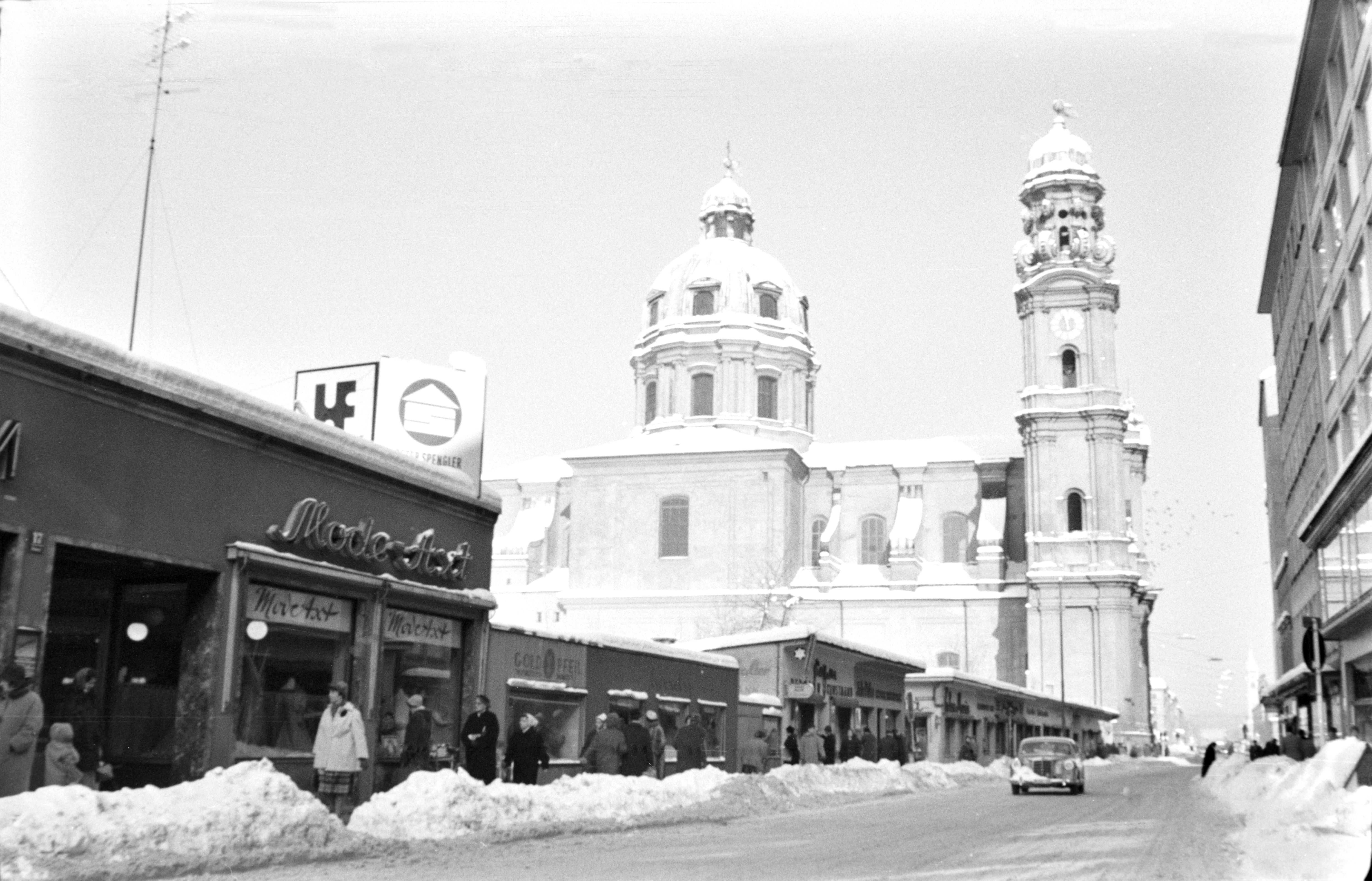Theatinerstraße on:
[Wikipedia]
[Google]
[Amazon]
Theatinerstraße is a street in 
Munich
Munich is the capital and most populous city of Bavaria, Germany. As of 30 November 2024, its population was 1,604,384, making it the third-largest city in Germany after Berlin and Hamburg. Munich is the largest city in Germany that is no ...
's old town
In a city or town, the old town is its historic or original core. Although the city is usually larger in its present form, many cities have redesignated this part of the city to commemorate its origins. In some cases, newer developments on t ...
. It connects the Odeonsplatz
The Odeonsplatz is a large square in central Munich which was developed in the early 19th century by Leo von Klenze and is at the southern end of the Ludwigstraße, developed at the same time. The square is named for the former concert hall, ...
with the southern Marienhof and houses a number of classical buildings and several shops. The street received its name due to the adjoining Theatinerkirche; it used to be called ''Hintere Schwabinger Gasse''.

Location
The Theatinerstraße extends from theOdeonsplatz
The Odeonsplatz is a large square in central Munich which was developed in the early 19th century by Leo von Klenze and is at the southern end of the Ludwigstraße, developed at the same time. The square is named for the former concert hall, ...
south to the Marienhof. The Viscardigasse and the Perusastraße connect them with the residential road in the east; via the Salvatorstraße or the Maffeistraße, the western parallel road Kardinal-Faulhaber-Straße
The Kardinal-Faulhaber-Straße is a street in the old town of Munich. It runs from Salvatorplatz in a southwesterly direction to Promenadeplatz.
History
The street is in the '' Kreuzviertel''. Its earlier names were ''Barts Gassen'' (around 137 ...
can be reached. At the height of the Marienhof, the Theatinerstraße turns into Weinstraße at the junction Schäfflergasse, which then leads past the New Town Hall to the Marienplatz. The Theatinerstraße–Weinstraße is part of the north-south medieval trade route, which existed at the time of the city's founding in the 12th century and crossed the salt road at Marienplatz in an east-west direction. The transition from the Weinstraße to the Theatinerstraße marks the border of the medieval so-called Heinrichsstadt. There, until 1691, the ''Hinteres Schwabinger Tor'' (rear Schwabinger Tor) also called ''Wilbrechtsturm'' (Wilbrecht tower), was located. Until 1817, the outer Schwabinger Tor stood at the northern end of Theatinerstraße.
Shopping street
Many international companies have branches on Theatinerstraße, includingArmani
Giorgio Armani S.p.A. (), commonly known as Armani, is an Italian luxury fashion house founded in Milan by Giorgio Armani which designs, manufactures, distributes and retails haute couture, ready-to-wear, leather goods, shoes, accessories, and ...
, Bassetti
Bassetti is an Italian textile company.
It was founded in Milan in 1830 by Carlo Barboncini, as a textile emporium. In 1840, it opened a hand-weaving factory at Rescaldina, some 25 km to the north west, which employed around fifty women. Tod ...
, Butlers
A butler is a person who works in a house serving and is a domestic worker in a large household. In great houses, the household is sometimes divided into departments, with the butler in charge of the dining room, wine cellar, and pantry. Some al ...
, Zara
Zara may refer to:
Businesses
* Zara (retailer), a fashion retail company based in Spain
* Zara Investment Holding, a Jordanian holding company
* Continental Hotel Zara, Budapest, Hungary
People and fictional characters
* Zara (name), primari ...
, Esprit and Bose
Bose may refer to:
* Bose (crater), a lunar crater.
* ''Bose'' (film), a 2004 Indian Tamil film starring Srikanth and Sneha
* Bose (surname), a surname (and list of people with the name)
* Bose (given name), a given name
* Bose, Italy, a ''fra ...
. It also houses the '' Fünf Höfe'', which houses another 60 shops, several restaurants and the Kunsthalle of the ''Hypo-Kulturstiftung''.
Transportation
The entire Theatinerstraße is declared apedestrian zone
Pedestrian zones (also known as auto-free zones and car-free zones, as pedestrian precincts in British English, and as pedestrian malls in the United States and Australia) are areas of a city or town restricted to use by people on foot or ...
and not is passable for motorized individual traffic.
With the Munich Underground, the Theatinerstraße can be reached from the underground station Odeonsplatz
The Odeonsplatz is a large square in central Munich which was developed in the early 19th century by Leo von Klenze and is at the southern end of the Ludwigstraße, developed at the same time. The square is named for the former concert hall, ...
via the lines U3, U4, U5 and U6. Also at Odeonsplatz, there is a bus stop served by lines N40, N41 and 100. For the Munich tram there is the Theatinerstraße stop at the corner of Maffeistraße, which is served by the line 19.
Attractions
* Palais Moy (D-1-62-000-979) *Palais Preysing
The Palais Preysing is a Rococo style building at Residenzstraße 27, opposite the Munich Residenz, Residenz in Munich, Southern Germany, which served as residence for the Counts of Preysing. To distinguish it from the nearby Palais Neuhaus-Pre ...
* Arco-Palais
The Arco-Palais is a commercial building in Munich's Old Town, Theatinerstraße 7, at the corner of Theatinerstraße / Maffeistraße. Together with the building at Maffeistraße 4, it forms a building block which is registered as a historical mon ...
(D-1-62-000-6844)
* Feldherrnhalle
The Feldherrnhalle ("Field Marshals' Hall") is a monumental loggia on the Odeonsplatz in Munich, Germany. Modelled after the Loggia dei Lanzi in Florence, it was commissioned in 1841 by King Ludwig I of Bavaria to honour the tradition of th ...
(D-1-62-000-4933)
* Theatinerkirche (D-1-62-000-6847)
References
{{Authority control Streets in Munich Buildings and structures in Munich Historicist architecture in Munich